CHURCH OF SATAN TIMELINE
1930 (11 April): Anton LaVey was born in Chicago, Illinois.
1951: LaVey married fifteen year-old Carole Lansing.
1952: LaVey’s first daughter, Karla, was born to LaVey and Lansing.
1960: LaVey divorced Carole Lansing and formed a relationship with Diane Hegarty.
1964: LaVey’s second daughter, Zeena Galatea, was born to LaVey and Hegarty.
1966: Anton LaVey founded the Church of Satan in San Francisco, California.
1967: The Church of Satan performed a satanic wedding ceremony, prompting widespread media interest in the group.
1969: LaVey published the Satanic Bible, outlining the principles of LaVeyan Satanism.
1975: Michael Aquino, a former leader in the Church of Satan, left the church to found the Temple of Set.
1980: LaVey and Diane Hegarty divorced.
1993: LaVey’s only son, Satan Xerxes Carnacki LaVey, was born to LaVey and Blanche Barton.
1997: Anton LaVey died as a result of a pulmonary edema, and Blanche Barton became the Church of Satan’s High Priestess.
2001: Peter Gilmore became High Priest of Church of Satan after Barton stepped down.
2002: Peggy Nadramia became High Priestess of Church of Satan.
2006: The Church of Satan held its first public Satanic Mass in 40 years.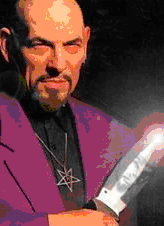
GROUP/FOUNDER HISTORY
Anton Szandor LaVey [Image at right] was born Howard Stanton Levey in
Chicago on April 11, 1930 to Michael Joseph Levey and Gertrude Coultron. Both had become naturalized American citizens in 1900. Soon after he was born, LaVey’s parents moved to the San Francisco Bay Area where he spent his childhood. He attended Tamalpais High School in Mill Valley, California but dropped out of school and hence was largely self-educated through his life (Knowles 2005). LaVey evidenced musical abilities from an early age and later used those talents as a musician, playing calliope and organ in a variety of venues to support himself financially. He met and married fifteen year-old Carol Lansing in 1950, and the couple gave birth to his first daughter, Karla, two years later. LaVey’s parents allowed the couple to use their home as a residence. The marriage lasted a decade until 1959 when LaVey met and was captivated by Diane Hegarty, who has described herself as a sorceress. He divorced Lansing the following year and began a relationship with Hegarty that lasted for 25 years. 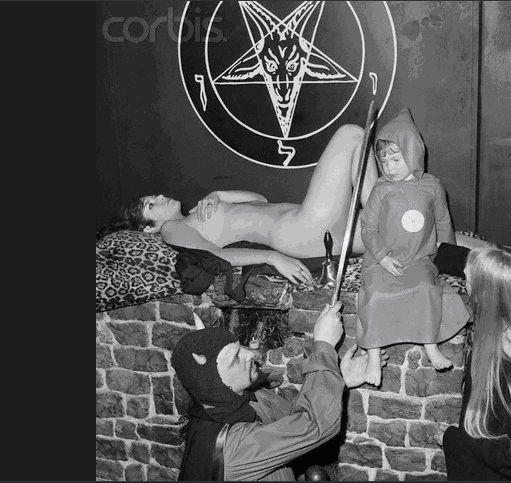 Although the couple never married, they were subsequently given joint title to LaVey’s parents’ home. In 1964, Hegarty and LaVey gave birth to a daughter, [Image at right] Zeena Galatea LaVey. The couple divorced in 1980. LaVey subsequently developed a relationship with Blanche Barton, who became his final companion and bore him his only son, Satan Xerxes Carnacki LaVey in 1993.
Although the couple never married, they were subsequently given joint title to LaVey’s parents’ home. In 1964, Hegarty and LaVey gave birth to a daughter, [Image at right] Zeena Galatea LaVey. The couple divorced in 1980. LaVey subsequently developed a relationship with Blanche Barton, who became his final companion and bore him his only son, Satan Xerxes Carnacki LaVey in 1993.
A major turning point in LaVey’s life and career occurred on April 30, 1966, Walpurgisnacht (a day of celebration drawn from the Pagan tradition on which the advent of spring is welcomed, often with dancing and bonfires). On that day he reportedly shaved his head, donned a hooded black robe, and pronounced himself the High Priest of the Church of Satan and the “Black Pope.” LaVey then asserted 1966 to be Anno Satanas, the first year of the Age of Satan. The self-proclaimed High Priest continued to live in his parents’ home, which also served as the headquarters of the Church of Satan. He painted the house black and purple, and it became popularly known simply as the “Black House.”
LaVey began to fashion his public career when, together with underground filmmaker Kenneth Anger, he organized both the Magic Circle, an occult discussion group, and a topless nightclub act called the “Witches Sabbath,” with strippers dressed as witches and vampires, where he promoted his philosophy. The Church of Satan received national media attention in 1967 when LaVey presided over the first satanic wedding ceremony, marrying a radical journalist, John Raymond, and a New York socialite, Judith Case. He then began performing satanic funerals, including one for Edward Olsen, a serviceman in the U.S. Navy, and baptisms, including one for his three year old daughter, Zeena. In Zeena’s baptism LaVey welcomed her to the “way of darkness:” In the name of Satan, Lucifer … welcome a new mistress, Zeena, creature of ecstatic magic light … in the name of Satan, we set your feet upon the left hand path … And so we dedicate your life to love, to passion, to indulgence, and to Satan, and the way of darkness. Hail Zeena! Hail Satan! (Barton 1990:90).
For his part, LaVey began developing an exotic persona and quickly became a media celebrity (Raymond 1998). He conducted a 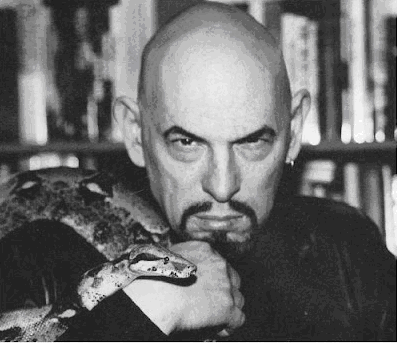 satanic ritual with a nude member of his congregation, Lois Morgenstern, serving as the altar; drove a coroner’s van as a car; painted the walls of his home black; and kept a variety of exotic pets (a tarantula, python, and pet Nubian lion named Tolgare). In 1968, he released his first record album, “The Satanic Mass.” A string of celebrities, including Jayne Mansfield, Sammy Davis Jr., King Diamond and Marilyn Manson also were linked to the Church of Satan during this period. LaVey gained further public visibility by appearing regularly in national printed media (Look Magazine, Newsweeek Magazine, Time Magazine) and on television talk shows (The Johnny Carson Show, The Phil Donahue Show).
satanic ritual with a nude member of his congregation, Lois Morgenstern, serving as the altar; drove a coroner’s van as a car; painted the walls of his home black; and kept a variety of exotic pets (a tarantula, python, and pet Nubian lion named Tolgare). In 1968, he released his first record album, “The Satanic Mass.” A string of celebrities, including Jayne Mansfield, Sammy Davis Jr., King Diamond and Marilyn Manson also were linked to the Church of Satan during this period. LaVey gained further public visibility by appearing regularly in national printed media (Look Magazine, Newsweeek Magazine, Time Magazine) and on television talk shows (The Johnny Carson Show, The Phil Donahue Show).
While LaVey became something of a celebrity, the Church of Satan never made him a wealthy man, his claims notwithstanding. By the mid-1970s he and his wife lived at a near poverty level, and LaVey relied on generosity of family and supporters for much of the rest of his life. He lost the headquarters of the Church of Satan, the Black House, which was ultimately demolished in 2001 by the real estate firm that had gained ownership. When membership and public interest in the Church of Satan declined in the 1970s, LaVey withdrew from public view. (Boulware 1998; Lattin 1999). He reappeared for a time during the 1990s, making several music albums, most notably Satan Takes a Holiday in 1995. Two years later LaVey died on October 29 of a pulmonary edema (fluid in the lungs). The original death certificate erroneously listed the date of his death as October 31 (Halloween), possibly in an effort to support his satanic persona, but was later corrected. At the time of his death he was writing Satan Speaks (1998), which was published posthumously the following year and contained an introduction by Marilyn Manson.
The Church of Satan held a public Satanic High Mass for the first time in 40 years in Hollywood, California on June 6, 2006 (06/06/06), in part mocking popular superstitions about the Devil’s number (“666”). One hundred invitations were issued to the private gala, which drew considerable media attention.
DOCTRINES/BELIEFS
Satanism has assumed a variety of form s, real and imagined, through human history. Allegations of organized worship of Satan can be traced to Europe during the Middle Ages. Fears of Satan worship surfaced during the 15th century witch hunts, and Christian manuals were produced for depicting and combating Satanism, most notably the Malleus Maleficarum (circa 1486) and Compendium Maleficarum (circa 1620). Historians suggest the existence of a satanic cult in the royal court of Louis XIV that conducted “Black Masses” to mock the Catholic Mass. There were also a few practicing satanists in Europe during the latter nineteenth century that triggered Satanism fears. In America, colonial era New England experienced a period of witchcraft allegations and witch hunting. Beyond the colonial witchcraft episode, satanic imagery has been perpetuated throughout American history by conservative Christian groups that believe that Satan is an active, personal presence in human affairs. Satan serves the function of explaining evil and misfortune, identifying heretical faiths, and bolstering Christian solidarity.
There are several strands of modern Satanism. As Peterson (2005:424) observes, Modern Satanism is a conglomerate of ideas expressed in distinctive ways by individual groups, and although both the groups and the underlying ideas may be difficult to press into a unified mold, they nonetheless display characteristic philosophical and indeed religious aspirations. Peterson (2011:223-24) distinguishes three types of “Satanic milieu:” reactive esoteric, and rational. Ractive Satanism “is in opposition to society, but in a way that reiterates central Christian concepts of evil, making it paradigmatically conform to a Christian context. Satan, is the Devil, and Satanism the adolescent or anti-social behavior of transgressing boundaries and ‘living out’ the mythical frame. Esoteric Satanism is more theistically oriented and uses the esoteric traditions of Paganism, Western Esotericism, Buddhism and Hinduism, among others, to formulate a religion of self-actualization.” Finally, rational Satanism is “an atheistic, skeptical Epicureanism….It considers Satan to be a symbol of rebellion, individuality, carnality and empowerment, and Satanism the material philosophy best suited for the ‘alien elite’; catchwords are indulgence and vital existence.”
The Church of Satan represents the best-known rationalist-oriented satanic group. The foundation of Church of Satan doctrine is found in Anton LaVey’s Satanic Bible , published in 1969. The Satanic Bible instantly became a best seller and has remained in print continuously since 1969. Sales figures aside, the book remains a foundational source among many Satanists. However, LaVey published several other books that further developed his philosophy. The Compleat Witch was published in 1971 (and released again in 1989 as The Satanic Witch). This book provides instruction of using lesser magic to manipulate others in order to achieve one’s own goals. The Satanic Rituals (1972) describes a variety of satanic rituals he discovered in cultures around the world and was intended to supplement the Satanic Bible. Two later volumes were The Devil’s Notebook (1992) and Satan Speaks (1998). LaVey also disseminated his ideas through the church’s periodical, The Cloven Hoof, which later became The Black Flame.
found in Anton LaVey’s Satanic Bible , published in 1969. The Satanic Bible instantly became a best seller and has remained in print continuously since 1969. Sales figures aside, the book remains a foundational source among many Satanists. However, LaVey published several other books that further developed his philosophy. The Compleat Witch was published in 1971 (and released again in 1989 as The Satanic Witch). This book provides instruction of using lesser magic to manipulate others in order to achieve one’s own goals. The Satanic Rituals (1972) describes a variety of satanic rituals he discovered in cultures around the world and was intended to supplement the Satanic Bible. Two later volumes were The Devil’s Notebook (1992) and Satan Speaks (1998). LaVey also disseminated his ideas through the church’s periodical, The Cloven Hoof, which later became The Black Flame.
The idea for the Satanic Bible appears to have originated through an acquisitions editor at Avon Books who thought that there was a viable market for a book on satanic philosophy. The editor approached LaVey, who assembled his lectures and ritual material and combined them into a book. It is clear that LaVey’s philosophy was influenced by a number of other writers. Among the most significant were Might Is Right, an 1896 social Darwinist oriented book written by Ragnar Redbeard (a pseudonym); Aleister Crowley’s periodical, Equinox ; John Dee’s “Enochian Keys;” and Ayn Rand’s Atlas Shrugged (1957) (Schreck and Schreck 1998).
In his writings, most notably the Satanic Bible, Anton LaVey begins with the premises that human beings are simply animals and the Darwinist struggle for survival and survival of the fittest constitute the fundamental laws of nature. LaVeyan Satanism therefore bases its claim to legitimacy on rationality and acceptance of the empirically observable, physical laws of science. Indeed, LaVey asserts that there is no transcendent god or moral order. As Magus Peter Gilmore summarized the Church of Satan’s position (Shankbone 2007): “Satanism begins with atheism. We begin with the universe and say, “It’s indifferent. There’s no God, there’s no Devil. No one cares!” So you then have to make a decision that places yourself at the center of your own subjective universe….So by making yourself the primary value in your life, you’re your own God. By being your own God, you are comfortable about making your own decisions about what to value.”
Correspondingly, Satan is not an actual entity but rather a symbol or icon of acceptance of individualism and self-interest and rejection of institutional controls, particularly religion. The Devil thus simply symbolizes humanity’s true animal nature. At the same time, La Vey asserts that humans do possess a reservoir of power that they can control and that once unleashed can make humans gods. However, these “occult forces” are simply natural forces that are discoverable by science. As Church of Satan Magus, Peter H. Gilmore, puts it, Satanists do not believe in the supernatural, in neither God nor the Devil. To the Satanist, he is his own God. Stan is the symbol of Man living as his prideful, carnal nature dictates. The reality behind Satan is simply dark evolutionary force that permeates all of nature and provides the drive for survival and propagation inherent in all living things. Satan is not a conscious entity to be worshipped, rather a reservoir of power inside each human to be tapped at will” (Gilmore n.d.).
The Church of Satan is openly hostile to and contemptuous of Christianity for suppressing humanity’s naturally physical, animal nature and appetites by labeling them as sinful. From the church’s perspective, this makes Christianity a totalitarian, repressive influence. In addition to its rhetorical opposition to established churches, the Church of Satan calls for the strict taxation of donations to all churches. In its “anti-theology, the church inverts traditional Christian values, such as sexual constraints, pride and avarice, and elevates their opposites, such as indulgence, self-assertion, and sexual freedom, as satanic virtues. From a LaVeyan perspective, since human individuals and human life are the ultimate realities, they are also all that is sacred and the only agents capable of redemption.
The anti-establishment orientation of the Church of Satan is considerably broader than its opposition to institutional religion. The church espouses rebellion to all authority that limits the expression of individual autonomy and authenticity. Individuals, these Satanists hold, are diminished by the socialization process and negative conditioning that limits self-expression. For LaVeyan Satanists, individual interests should always be set above compliance with conventional norms, and individuals should freely indulge their mental, emotional, and physical qualities. There is a hard-bitten Darwinist flavor to the church’s “anti-theology,” as it endorses the survival of the fittest and overcoming the weak; it opposes universal human rights and equality. Members regard themselves as an “Alien Elite.”
The atheistic, hedonistic, anti-establishment, individualistic, and elitist orientation of the Church of Satan is clearly expressed in its “Nine Satanic Statements” (LaVey 1969:25).
* Satan represents indulgence, instead of abstinence!
* Satan represents vital existence, instead of spiritual pipe dreams!
* Satan represents undefiled wisdom, instead of hypocritical self-deceit!
* Satan represents kindness to those that deserve it, instead of love wasted on ingrates!
* Satan represents vengeance, instead of turning the other cheek!
* Satan represents responsibility to the responsible, instead of concern for psychic vampires!
* Satan represents man as just another animal, sometimes better, often worse than those that walk on all fours, who, because of his “divine spiritual and intellectual development,” has become the most vicious animal of all!
* Satan represents all of the so-called sins, as they all lead to physical, mental, or emotional gratification! ● Satan has been the best friend the church has ever had, as he has kept it in business all these years!
There do appear to be limits to endorsement of individual freedom and indulgence. The self that is to be expressed is the authentic self. In the list of “Nine Satanic Sins,” members are warned against qualities such as stupidity, pretentiousness, self-deceit, and herd conformity that would be indicators of non-authenticity, and the non-conformity that is advocated is “productive non-conformity.” Further, members are enjoined from drug use and consumerism that would undermine rationality and unique individual expression. Finally, in the “Eleven Satanic Rules of Earth,” devotees are warned against harming children, killing non-human animals, attacking others unless assaulted first. Magus Peter Gilmore (Shankbone 2007) summarized the church’s position this way: “When we deal with other people, our approach is that we want to have maximum freedom, and maximum responsibility without infringing on people as much as possible. So we would set up laws so we really don’t have to spend all of our time defending our territory, being in some kind of castle keep situation.”
RITUALS/PRACTICES
Early in the Church of Satan’s history the “Black Mass” was performed as a means of expressing opposition to Christianity and 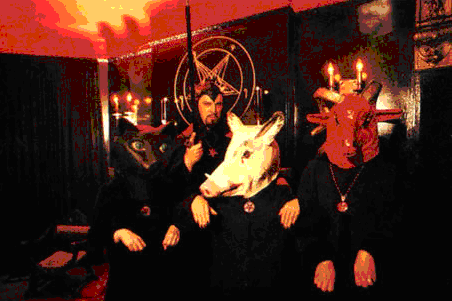 other institutionalized religion. [Image at right] Specifically, it was organized as a parody of the Roman Catholic Mass, but the symbolic significance was broader. According to LaVey, the Black Mass functioned as a psychodrama through which cathartic blasphemies could be expressed. The anti-Christian symbolism was evident in the incorporation hooded robes; an inverted crucifix; a nude woman used as an altar; and baptisms, weddings, and funerals, with satanic content. As the church became established, these rituals were discontinued, although they continued to be linked to the church in the public mind. The pentagram and Sigil of Baphomet (a point-down pentagram inside a circle, with a goat’s head inside the pentagram) continue to be important symbols of Satanism.
other institutionalized religion. [Image at right] Specifically, it was organized as a parody of the Roman Catholic Mass, but the symbolic significance was broader. According to LaVey, the Black Mass functioned as a psychodrama through which cathartic blasphemies could be expressed. The anti-Christian symbolism was evident in the incorporation hooded robes; an inverted crucifix; a nude woman used as an altar; and baptisms, weddings, and funerals, with satanic content. As the church became established, these rituals were discontinued, although they continued to be linked to the church in the public mind. The pentagram and Sigil of Baphomet (a point-down pentagram inside a circle, with a goat’s head inside the pentagram) continue to be important symbols of Satanism.
At the center of the church’s ritual practice is magic, which is understood to be the capacity to change outcomes, which could not be changed through ordinary methods, in accordance with one’s will (LaVey 1969:110). There are two basic categories of magic, lesser and greater. There is no distinction between “white” and “black” magic as magic is believed to be inherently amoral. Lesser magic is a system of manipulation that draws on one’s natural abiity to manipulate others. There are three types: sexual (with the objective being seduction and ecstasy), compassionate (with the objective being helping loved ones), and destructive (with the objective being to release anger). Greater magic involves influencing external events by creating an extreme emotional state that produces high levels of adrenaline. If the levels are high enough, one’s vision of what one wishes to happen will penetrate the unconscious mind of the person being influenced. If the time is right, the person will behave as the influencer wishes (Gilmore n.d; Lap 2006).
The Church of Satan observes only a few distinctive celebrative occasions. Consistent with its individualistic thrust, the most significant celebrative date annually is one’s own birthdate. This celebration signifies to members that they are the god in their own lives. Three other important, but not sacred, dates referred to in the Satanic Bible are Walpurginsnacht, which celebrates both the welcoming of spring and the founding of the Church of Satan in 1966; summer and winter solstices; and spring and fall equinoxes. Satanists are free to celebrate other cultural and religious holidays but generally treat those occasions in a secular fashion.
ORGANIZATION/LEADERSHIP
LaVey and his followers crafted an elaborate hagiography to demonstrate his extraordinary qualities. In the hagiographic account, La Vey’s grandmother was a Transylvanian gypsy who introduced him to the occult as a child. LaVey ran away from home at age 16 and then worked successively in jobs such as an oboe player in the San Francisco Ballet Orchestra, circus lion tamer with the Clyde Beatty Circus, stage hypnotist, nightclub organist, and police department photographer. He also claimed romantic affairs with Marilyn Monroe and Jayne Mansfield. Most of the details contained in the hagiographic account were subsequently refuted as former supporters abandoned LaVey and investigative journalists began probing official records for information.
Despite a variety of challenges to his hagiography and leadership, LaVey led the Church of Satan until his death in 1997. Initially, LaVey’s daughter, Karla, announced that she and LaVey’s partner, Blanche Barton, would serve jointly as co-High Priestesses. However, a legal dispute then erupted, which led to a settlement stipulating that assets (personal belongings, writings and accompanying royalties) would be divided among the three children (Zeena, Karla, and Xerxes). Barton was granted ownership of the corporate entity, the Church of Satan, and she held ownership for four years while moving the church headquarters to the Hell’s Kitchen neighborhood in New York City. In 2001, Barton appointed Peter H. Gilmore, who had been a long-time member of the church’s Council of Nine, as Magus. Peggy Nadramia became the High Priestess the following year. Karla LaVey subsequently founded the First Satanic Church in San Francisco.
His opposition to institutionalized religion notwithstanding, LaVey concluded that it was necessary to establish a church because he thought that people continued to need the rituals and worship that organized religion provided. As LaVey put it, “People need ritual, with symbols that they may find in baseball games or church services or wars, as vehicles for expending emotions they can’t release or even understand on their own” (Gilmore 2007). He founded the Church of Satan after one of the members of his Magic Circle suggested that a church would be the best vehicle for disseminating his ideas. He was also encouraged by a professional publicist and supporter, Edward Webber, who told LaVey that he “would never make any money by lecturing on Friday nights for donations … it would be better to form some sort of church and get a charter from the State of California … I told Anton at the time that the press was going to flip out over all this and that we would get a lot of notoriety” (Schreck and Schreck 1998).
La Vey initially organized the church into local units, grottoes, which were controlled directly by the church. At the height of the church’s popularity there were grottos in many major cities in the U.S. In 1975, LaVey abolished the grotto system. Blanche Barton (2003) describes the rationale for this decision as follows: “By 1975, a re-organization had taken place and those few who were counterproductive to LaVey’s Satanic ideals, who were more interested in what Anton called “Phase One Satanism” (i.e., group rituals, blaspheming Christianity in a rigidly-structured, limited way) were phased out. With his intensely elitist attitude, Anton was incensed to see his creation degenerating into a “Satan Fan Club,” where the weakest, least innovative members were buoyed up with time and attention at the expense of the most productive, most Satanic members…. LaVey wanted his Church of Satan to evolve into a truly cabalistic underground rather than degenerating into a long-running public pageant or a “Satan pen pal club.” The result was a much more decentralized organization. According to Peterson (2005:430), “Today the Church of Satan is essentially a decentralized, cell-like structure where first-level (registered) membership is attained by filling out a registration statement and paying a hundred dollars to the central administration. Individual members have as much contact with the organization as needed, and most members have little to do with the church or even local grottoes.” The grottoes are independent and self-sufficient. The church itself is administered by a Council of Nine. The council “concentrates on matters of doctrine, general guidelines, and administration of Dr. LaVey’s estate (through the Order of the Trapezoid). As such, the council is engaged in protecting the authority of LaVey’s writings and is only concerned with individual members’ beliefs and practices when they run counter to the interests of the church…” (Peterson (2005:430).
The Church of Satan has two types of members: Registered Members and Active Members. Both must be legally adults. Registered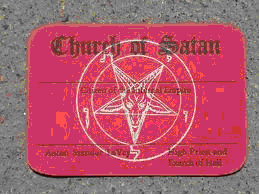 Members are those who have registered and paid the stipulated fee; [Image at right] there are not other requirements for this basic membership. There are five degrees of Active Membership, which available only by invitation. The top three degrees constitute the priesthood and are addressed as either Reverend or “Magister/Magistra” and “Magus/Maga.” The priesthood represents the Church of Satan as spokespersons and constitutes the governing body, the Council of Nine. The Church of Satan has claimed hundreds of thousands of members. While the Satanic Bible has probably sold 1,000,000 copies and has remained in print continuously since its publication, the popularity of the philosophy has not been matched church membership. Even the most generous estimates have been no more than a few thousand at the height of the church’s visibility, and more realistic estimates are several hundred at its peak.
Members are those who have registered and paid the stipulated fee; [Image at right] there are not other requirements for this basic membership. There are five degrees of Active Membership, which available only by invitation. The top three degrees constitute the priesthood and are addressed as either Reverend or “Magister/Magistra” and “Magus/Maga.” The priesthood represents the Church of Satan as spokespersons and constitutes the governing body, the Council of Nine. The Church of Satan has claimed hundreds of thousands of members. While the Satanic Bible has probably sold 1,000,000 copies and has remained in print continuously since its publication, the popularity of the philosophy has not been matched church membership. Even the most generous estimates have been no more than a few thousand at the height of the church’s visibility, and more realistic estimates are several hundred at its peak.
ISSUES/CHALLENGES
The Church of Satan and its leader, Anton LaVey, both experienced a variety of challenges. These included refutations of LaVey’s elaborate hagiography, defections by key supporters, the formation of schismatic groups, and the impact of the Satanism scare.
LaVey had been able to maintain the hagiographic account of his life without challenge for over two decades until his daughter, Zeena, broke relations with him in 1990 and an investigative journalist, Lawrence Wright, began digging in public records. In 1990, Zeena LaVey Schreck renounced her “unfather,” resigned from the Church of Satan, and attacked Blanche Barton’s biography of LaVey, The Secret Life of a Satanist (1990) as an “absurb catalogue of lies” full of “self-serving bullshit” (Schreck 1990). The couple went on to found the Sethian Liberation Movement in 2002 that set as its goal allowing individuals to practice magic outside of an oppressive, sectarian atmosphere and assist former cult members (Lamothe-Ramosa n.d.). The following year Lawrence Wright (1991) wrote an exposé article in Rolling Stone that discredited the hagiography before a much larger audience.
Virtually all of the details in LaVey’s hagiography were challenged. A mounting number of critics concluded that he had no Gypsy ancestry, there was no San Francisco Ballet Orchestra at the time he claimed to have been an oboist in the group, nor was there an “official city organist” in San Francisco; there is no record of LaVey being a lion tamer in the Clyde Beatty Circus, LaVey had never even met Marilyn Monroe, let alone having had an affair with her; he never studied Criminology at San Francisco City College or worked in any capacity with the San Francisco Police Department; LaVey was not involved in the production of Rosemary’s Baby and had never met its director, Roman Polanski. LaVey’s response to the shattering of his satanic persona was remarkably temperate when confronted by Wright (1991): “’I don’t want the legend to disappear,’ LaVey told me anxiously in our last conversation, after I confronted him with some of the inconsistencies in his story. ‘There is a danger you will disenchant a lot of young people who use me as a role model.’ He was especially offended that I had tracked down his eighty-seven-year-old father in an effort to verify some of the details of LaVey’s early life. ‘I’d rather have my background shrouded in mystery. Eventually you want to be recognized for what you are now’.” In another moment, he was perhaps more candid: “I’m one helluva liar. Most of my adult life, I’ve been accused of being a charlatan, a phony, an impostor. I guess that makes me about as close to what the Devil’s supposed to be, as anyone … I lie constantly, incessantly” (LaVey 1998:101).
The Church of Satan faced a wave of organizational innovations and schismatic groups. In addition to founding of Sethian Liberation Movement by Zeena LaVey Schreck and the First Satanic Church by Karla LaVey, there was a major challenge from Michael Aquino, who founded the Temple of Set. Aquino led several dozen defectors from the Church of Satan in 1975 to found the Temple of Set in 1975, citing disagreement with LaVey over selling degrees and atheistic doctrines, as Aquino teaches that there is a living satanic deity, Set. Beyond these challenges, there were numerous other groups that sought to innovate on the Church of Satan or broke organizationally with the church (Bromley and Ainsley 1995). These include the Church of Satanic Brotherhood, Universal Church of Man, Brotherhood of the Ram, Our Lady of Endor, Coven of the Ophite Cultus Satanas, Thee Satanic Orthodox Church of Nethilum Rite, Thee Satanic Church, Kerk du Satan – Magistralis Grotto and Walpurga Abbey, Church of Satanic Brotherhood, Ordo Templi Satanas, Order of the Black Ram and the Shrine of the Little Mother, and Temple of Nepthys. Most of these groups were relatively small and ephemeral.
Finally, during the 1980s a wave of satanic subversion fear swept North America and Europe, centering around claims of the existence a massive, international, underground, hierarchically organized satanic network (Bromley 1991; Richardson, Best, and Bromley 1991). Satanists putatively were involved in a range of nefarious activity; the most horrific allegations involved the abduction of children, child abuse, commercial production of child pornography, sexual abuse and incest, and ritualistic sacrifices of young children. At the height of the subversion episode, ritual abuse victims were estimated at 50,000 annually, and there were numerous sensational ritual abuse prosecutions.
Proponents of satanic cult theory claimed that Satanism was organized at four levels, with involvement often beginning at lower levels and subsequently graduating to higher level activity. At the lowest level are “dabblers,” typically adolescents who are lured into Satanism through experimentation with heavy metal music and fantasy games containing embedded satanic themes. More sinister were the “self-styled satanists” who employed satanic imagery in committing anti-social activity and were thought to be members of satanic cults. The public face of Satanism was “organized satanists,” consisting of the satanic churches, which publicly engaged in the worship of Satan. Orchestrating the entire range of satanic activity were the “traditional satanists,” who were organized into an international, secret, hierarchically structured, tightly organized cult network that engaged in ritual abuse and sacrifice of children.
The Church of Satan, given its high public profile, was often cited by proponents of the satanic conspiracy as evidence that there were easily identifiable devil worshipers. Church leaders appeared on numerous television talk shows in an attempt to distinguish legitimate satanic worship from the purported satanic cults. Whatever the effect of the defenses mounted by Church of Satan spokespersons, this challenge was defused primarily by the collapse of what has been termed “the satanic panic.” Professional and governmental groups challenged the validity of repressed memory evidence offered by claimants, no convincing physical evidence was produced to support allegations, court convictions were reversed, and American and European governmental investigations concluded that conspiracy claims were without foundation ( Hicks 1994; La Fontaine 1994; Lanning 1989).
REFERENCES
Barton, Blanche. 2003. The Church of Satan: A Brief History. Accessed from http://www.churchofsatan.com/Pages/CShistory7LR.html on 28 July 2012.
Blanche Barton. 1990. The Secret Life of a Satanist: The Authorized Biography of Anton LaVey. Port Townsend, WA: Feral House.
Boulware, Jack. “A Devil of a Time: How is the Church of Satan Getting Along? Not So Hot.” The Washington Post 30 August 1998: F1.
Bromley, David. 1991. “Satanism: The New Cult Scare.” Pp. 49-74 in The Satanism Scare, edited by James Richardson, Joel Best, and David Bromley. Hawthorne, NY: Aldine de Gruyter.
Bromley, David G., and Susan Ainsley. 1995. “Satanism and Satanic Churches: The Contemporary Incarnations.” Pp. 401-09 in America’s Alternative Religions , edited by Timothy Miller. Albany: State University of New York.
Gilmore, Peter. 2007. “What, The Devil?” Accessed from http://www.churchofsatan.com/Pages/WhatTheDevil.html on 29 July 2012.
Gilmore, Peter. n.d. “Satanism: The Feared Religion.” Accessed from http://www.churchofsatan.com/Pages/Feared.html on 27 July 2012.
Hicks, Robert. 1991. In Pursuit of Satan: The Police and the Occult. Buffalo, NY, 1991.
Knowles, George. 2005. “Satanism.” Accessed from http://www.controverscial.com/Satanism%20-%20Anton%20LaVay.htm on 1 August 2012.
La Fontaine, Jean. 1994. Extent & Nature of Organized Ritual Abuse: Research and Findings. London: Her Majesty’s Stationery Office.
Lattin, Don. 1999. “Satan’s Den in Great Disrepair: Relatives of S.F. hellhound Anton LaVey battle over `Black House’.” San Francisco Chronicle 25 January 1999. Accessed from http://www.sfgate.com/cgi-bin/article.cgi?file=%2Fchronicle%2Farchive%2F1999%2F01%2F25%2FMN77329.DTL on 1 August 2012.
Lamothe-Ramos, Annette. n.d. “Beelzebub’s Daughter: How Zeena Schreck Escaped the Church of Satan.” Accessed from http://www.vice.com/en_uk/read/beelzebubs-daughter-0000175-v19n4?Contentpage=-1 on 1 August 2012.
Lap, Amina. 2008. “Categorization of Modern Satanism—An Analysis of LaVey’s Early Writing.” Accessed from http://blog.blazingangles.net/soapbox/images/Categorization-of-Modern-Satanism.pdf on 28 July 2012.
Lanning, Kenneth. 1989. “Satanic, Occult, Ritualistic Crime: A Law Enforcement Perspective.” The Police Chief LVI: 62-83.
LaVey, Anton. 1998. Satan Speaks. Port Townsend, WA: Feral House.
LaVey, Anton. 1992. The Devil’s Notebook. Port Townsend, WA: Feral House.
LaVey, Anton. 1972. The Satanic Rituals. New York: Avon Books.
LaVey, Anton. 1971. The Compleat Witch, or, What to do When Virtue Fails. New York: Dodd, Mead.
Peterson, Jesper. 2005. “Modern Satanism: Dark Doctrines and Black Flames.” Pp. 423-57 in Controversial New Religions, edited by James Lewis and Jesper Petersen. New York: Oxford University Press.
Rand, Ayn. 1957. Atlas Shrugged. New York: Random House.
Raymond, John. 1998. “The Satanic Verses; How One Man Helped Get The Church of Satan Off the Ground.” The SF Weekly. 1 July 1998. Accessed from http://www.sfweekly.com/1998-07-01/calendar/the-satanic-verses/ on 1 August 2012.
Redbeard, Ragnar. 1996. Might is Right. Chicago: M.H.P. & Co., Ltd.
Richardson, James, Joel Best and David Bromley, eds. 1991. The Satanism Scare. Hawthorne, NY: Aldine de Gruyter.
Schreck, Zeena. 1990. “Letter to Michael Aquino.” 30 December 1990. Accessed from http://www.skeptictank.org/files/mys5/zeena.htm
Schreck, Zeena and Nikolas Schreck. 1998. Anton LaVey: Myth and Reality. Accessed from http://satanismcentral.com/aslv.html on 29 July 2012.
Shankbone, David. 2007. “Satanism: An interview with Church of Satan High Priest Peter Gilmore.” Wikinews 5 November 2007. Accessed from http://en.wikinews.org/wiki/Satanism:_An_interview_with_Church_of_Satan_High_Priest_Peter_Gilmore on 1 August 2012.
Wright, Lawrence. 1991.”Sympathy for the Devil: It’s Not Easy Being Evil in a World That’s Gone to Hell.” Rolling Stone 612:63-68, 105-106.
Post Date:
1 August 2012
